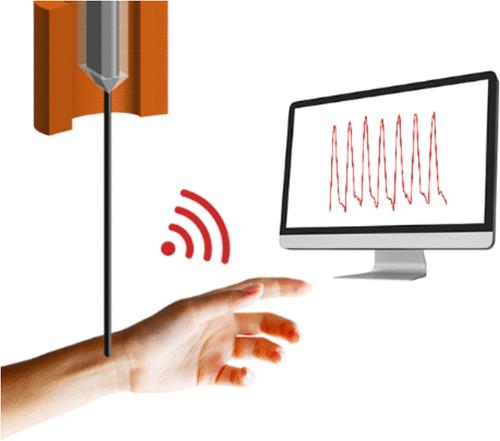当前位置:
X-MOL 学术
›
ACS Appl. Mater. Interfaces
›
论文详情
Our official English website, www.x-mol.net, welcomes your feedback! (Note: you will need to create a separate account there.)
Self-Poled Piezoelectric Nanocomposite Fiber Sensors for Wireless Monitoring of Physiological Signals
ACS Applied Materials & Interfaces ( IF 8.3 ) Pub Date : 2024-06-28 , DOI: 10.1021/acsami.4c04908 Md Mehdi Hasan 1, 2 , Mahmudur Rahman 1, 3 , Md Sazid Bin Sadeque 1 , Mustafa Ordu 1
ACS Applied Materials & Interfaces ( IF 8.3 ) Pub Date : 2024-06-28 , DOI: 10.1021/acsami.4c04908 Md Mehdi Hasan 1, 2 , Mahmudur Rahman 1, 3 , Md Sazid Bin Sadeque 1 , Mustafa Ordu 1
Affiliation

|
Self-powered sensors have the potential to enable real-time health monitoring without contributing to the ever-growing demand for energy. Piezoelectric nanogenerators (PENGs) respond to mechanical deformations to produce electrical signals, imparting a sensing capability without external power sources. Textiles conform to the human body and serve as an interactive biomechanical energy harvesting and sensing medium without compromising comfort. However, the textile-based PENG fabrication process is complex and lacks scalability, making these devices impractical for mass production. Here, we demonstrate the fabrication of a long-length PENG fiber compatible with industrial-scale manufacturing. The thermal drawing process enables the one-step fabrication of self-poled MoS2–poly(vinylidene fluoride) (PVDF) nanocomposite fiber devices integrated with electrodes. Heat and stress during thermal drawing and MoS2 nanoparticle addition facilitate interfacial polarization and dielectric modulation to enhance the output performance. The fibers show a 57 and 70% increase in the output voltage and current compared to the pristine PVDF fiber, respectively, at a considerably low MoS2 loading of 3 wt %. The low Young’s modulus of the outer cladding ensures an effective stress transfer to the piezocomposite domain and allows minute motion detection. The flexible fibers demonstrate wireless, self-powered physiological sensing and biomotion analysis capability. The study aims to guide the large-scale production of highly sensitive integrated fibers to enable textile-based and plug-and-play wearable sensors.
中文翻译:

用于生理信号无线监测的自极化压电纳米复合光纤传感器
自供电传感器有潜力实现实时健康监测,而无需满足不断增长的能源需求。压电纳米发电机(PENG)响应机械变形产生电信号,无需外部电源即可提供传感能力。纺织品符合人体结构,可作为交互式生物力学能量收集和传感介质,且不会影响舒适度。然而,基于织物的 PENG 制造工艺复杂且缺乏可扩展性,使得这些设备不适合大规模生产。在这里,我们演示了与工业规模制造兼容的长长度 PENG 纤维的制造。热拉丝工艺可一步制造自极化 MoS 2 - 聚偏二氟乙烯 (PVDF) 纳米复合纤维器件(与电极集成)。热拉伸和 MoS 2 纳米粒子添加过程中的热量和应力促进界面极化和介电调制,从而提高输出性能。在 3 wt% 的相当低的 MoS 2 负载量下,与原始 PVDF 纤维相比,该纤维的输出电压和电流分别增加了 57% 和 70%。外包层的低杨氏模量确保了应力有效传递到压电复合材料域,并允许微小运动检测。柔性纤维具有无线、自供电的生理传感和生物运动分析能力。该研究旨在指导高灵敏度集成纤维的大规模生产,以实现基于纺织品的即插即用可穿戴传感器。
更新日期:2024-06-28
中文翻译:

用于生理信号无线监测的自极化压电纳米复合光纤传感器
自供电传感器有潜力实现实时健康监测,而无需满足不断增长的能源需求。压电纳米发电机(PENG)响应机械变形产生电信号,无需外部电源即可提供传感能力。纺织品符合人体结构,可作为交互式生物力学能量收集和传感介质,且不会影响舒适度。然而,基于织物的 PENG 制造工艺复杂且缺乏可扩展性,使得这些设备不适合大规模生产。在这里,我们演示了与工业规模制造兼容的长长度 PENG 纤维的制造。热拉丝工艺可一步制造自极化 MoS 2 - 聚偏二氟乙烯 (PVDF) 纳米复合纤维器件(与电极集成)。热拉伸和 MoS 2 纳米粒子添加过程中的热量和应力促进界面极化和介电调制,从而提高输出性能。在 3 wt% 的相当低的 MoS 2 负载量下,与原始 PVDF 纤维相比,该纤维的输出电压和电流分别增加了 57% 和 70%。外包层的低杨氏模量确保了应力有效传递到压电复合材料域,并允许微小运动检测。柔性纤维具有无线、自供电的生理传感和生物运动分析能力。该研究旨在指导高灵敏度集成纤维的大规模生产,以实现基于纺织品的即插即用可穿戴传感器。











































 京公网安备 11010802027423号
京公网安备 11010802027423号